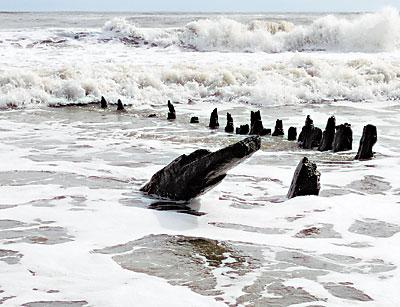Wreck of the Brig Mars Resurfaces

Severe erosion has again revealed the wooden bones of the Mars, a sailing vessel that went aground on a clear day about this time of year in 1828 at Georgica Beach east of Georgica Pond.
According to local lore as recorded by Jeannette Rattray in her book “Ship Ashore,” Mars was a well-built, nearly new brig fastened with copper bolts. According to Ms. Rattray’s account, “Two young men, Stephen Sherrill and John Osborn, bought the wreck where she lay for $100. They removed the furniture and trim from her cabin, the spars, sails, and much of her copper,” she wrote, referring to the copper sheathing that served as defense against marine worms.
Unfortunately for Sherrill and Osborn, a storm hit and waves covered the wreck with sand. The ship’s hull was not seen again until March of 1931 when a storm “ripped the Mars out of her sandy bed.” The wreck lay close to the summer homes of Grantland Rice and Ring Lardner, which were nearly taken by the same storm. Both were subsequently moved back from the sea.
The prevailing rumor at the time was that the Mars had carried slaves from Africa to the West Indies, and then sailed north ballasted with molasses. Although a federal law banning the importation of slaves was adopted in January of 1808, it was not well enforced, and the law did not prohibit United States flagged ships from carrying slaves to other countries.
Judge Henry P. Hedges of Bridgehampton reported that Mars had come ashore in fair weather. Her captain was a man named Ring. “Among the local men who went to view the Mars was a retired whaling captain, Jonathan Osborn of Wainscott. He questioned Captain Ring closely as to how often he had sounded,” meaning checked the depth under the brig.
“Old fellow, what do you know about a ship?” a testy Captain Ring was said to have responded. “If I should tell you, do you think you would know any more than you do now?”
Captain Osborn replied: “I have commanded a ship larger than your brig, and never ran her ashore, either.”
